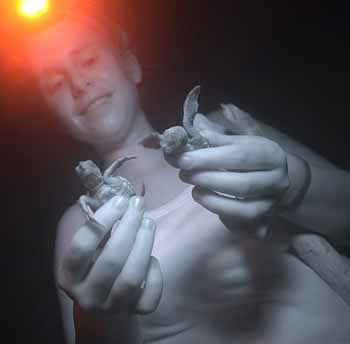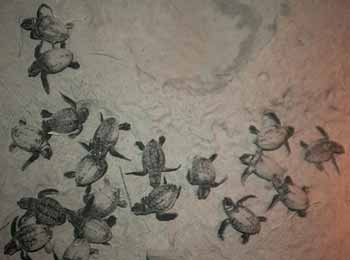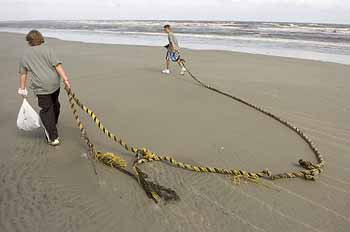Saving Loggerhead Sea Turtles
By Cindy Ross
Photographs by Walter Calahan
During their annual visit to a wilderness barrier island off the South Carolina coast, Scouts help vulnerable hatchlings survive a perilous journey from nest to sea.
The night sky over Pritchards Island had no moon, but the stars, so profuse they reached to the horizon, provided enough light for the visitors to see the sandy beach and ocean surf.
The 11 Scouts from Troop 171 (chartered to the Williamson's Chapel United Methodist Church, Mooresville, N.C.) were on their annual mission to help save loggerhead sea turtles. They carried buckets to use in assisting newly hatched baby turtles on their perilous journey from nest to ocean, and huge calipers for measuring any mother turtle they might encounter nesting in the remote setting.
 Marine science student Mamie Kruse collects hatchlings. |
Undeveloped and nearly deserted, Pritchards is one of the barrier islands off the coast of South Carolina and a nesting site for giant loggerhead turtles. It is also home to the University of South Carolina Beaufort's Center for Coastal Ecology.
The center provides hands-on environmental education in a dorm-style research facility. Each summer, individuals and groups flock to Pritchards to assist the staff in sea turtle nest location, protection, and management practices. (See sidebar).
For Troop 171, the trip has been an annual event for most of the past eight years, thanks to former Scoutmaster and current committee chairman David Nagy, a 24-year Scouting veteran. Ken Teeter, who succeeded Nagy as Scoutmaster, says the Scouts enjoy this special adventure, which for some can be a life-changing experience.
It was near the end of the 2005 May-to-August egg laying season as the Scouts patrolled the beach, looking for turtle hatchlings.
Because regular flashlights can disturb and confuse the turtles, Mamie Kruse, a marine science student at Belmont Abbey College near Charlotte, N.C., who was accompanying the Scouts, aimed a red beam at a bowl-shape depression in the sand. Little dark heads and front flippers appeared.
The Scouts stared in amazement at a group of hatchlings, resting after the rigorous task of pecking through their shells, which were buried in two feet of loose sand, and then struggling up to the surface.
Kruse carefully picked up each squirming, two-inch-long sand-covered baby turtle and placed it in a bucket. A half dozen more were working their way to the surface, and she gently probed the sand with her fingers to help them.
"The top hatchlings are the lucky ones," she explained. "Out of the 120 eggs the size of table-tennis balls that their mother has deposited nearly two months ago, they have the greatest chance for survival."
 Newborn turtles rest after climbing to the surface. |
The odds against survival are great. Only one in 10,000 eggs will become an adult, and only one of 1,000 hatchlings survives to adulthood.
The many threats include raccoons, who dig up nests to feast on the eggs; giant ghost crabs, who snatch newborns; gulls, who attack the baby turtles making their way toward the ocean; and hungry fish, who await in the surf. Turtles slow in reaching the water can also succumb to heat from the sun or swarms of ants.
The loggerhead sea turtle was named a threatened species by the federal government in 1978, when the mortality rate for newborns was nearly 100 percent. Since the turtle protection project began in 1982, more than 2,500 nests have been saved on Pritchards Island alone, and—thanks to the program and volunteers like Troop 171—60 to 80 percent of newborns—more than 240,000—saved.
The Scouts focused on their job for the night: escorting the hatchlings out to the sea.
A mother turtle prefers to deposit her eggs in loose sand with the right degree of dryness, away from artificial lights, and with no obstructions blocking the way to the ocean.
Darkness is important because the hatchlings have to see the contrast between the beach and the waves, depending on the sound of the surf and the light of the moon to direct them.
On a night with no moon, the hatchlings can be disoriented by lights from neighboring islands. In such situations, volunteers like the Scouts have to become the moon.
As Scout Tommy Markham waded knee-deep into the surf and aimed a white flashlight down into the water, Kruse rolled the bucket onto its side and the two dozen baby turtles scrambled out. Each Scout stood behind one or two turtles and gently coaxed them toward the water.
One hatchling turned around and crawled up a Scout's sneaker. Others seemed to head in every direction except toward the surf. "Should I help?" Scout after Scout asked.
"You don't need to handle them," Kruse assured them. "If you let them go, they should be able to figure it out for themselves."
The reason the turtles need to find their own way across the 80 yards of sand is so the location will be imprinted in their tiny brains. In about 20 to 25 years, once they reach maturity, the females will return to this same area to lay their eggs.
The beach was covered in drag lines, as the babies used their front flippers to pull their little bodies along, making three imprints in the sand.
Scouts combed the nearby grasses, looking for stragglers. One boy found a baby turtle tangled in a prickly pear cactus and removed a number of inch-long needles from it. As the hatchling then squirmed on its way as if nothing had occurred, the Scout looked on with pride.
Another boy happily rescued another turtle struggling in a deep depression with a three-foot yellow snake lurking nearby.
Eventually, the hatchlings reached the ocean and immediately began to swim in about one inch of water. The Scouts cheered as the young turtles paddled off in search of the Gulf Stream. From then on, the ocean would be their home, with only the females returning after maturity every three to five years to lay eggs in the same beach area where they were born.
Then Mamie Kruse told the Scouts that one baby turtle—hampered by a smaller-than-normal left flipper, was still struggling out of the nest.
Dubbing this last hatchling "Lil' Joe," the 11 Scouts encouraged it onward, watching compassionately as its progress was constantly deterred by waves rolling ashore. When the turtle became mired in a muck puddle, a Scout tenderly freed it but then set it down to continue its journey alone.
Like parents, the boys had learned when to help and when to let go.
Suddenly, a huge wave thundered in, flooding the beach up to the boys' knees and wiping the sand clean.
"Nobody move!" someone yelled after the water receded, but Lil' Joe was nowhere to be found.
Recovering from their shock and sense of loss, each Scout called out, "Good luck, Lil' Joe."
They realized that, as with dozens of other baby turtles they had helped throughout the night, they had done all they could to give this last young turtle a start in the world.
Cindy Ross is a frequent contributor to Scouting magazine.
Some Loggerhead Turtle Facts
|
A Wilderness Nesting Home for LoggerheadsPritchards Island was saved from the development that has occurred on other barrier islands off the coast of South Carolina when it was purchased in the 1970's by Atlanta businessman Philip A. Rhodes.
In 1982, Rhodes allowed University of South Carolina Beaufort biology professor David McCollum and some students to use the 1,600-acre island for a project that involved monitoring and protecting loggerhead sea turtles. A year later he decided to donate the island to the university, with the stipulation that it remain in a wilderness state as a location for research and conservation of the pristine barrier island ecosystem. The university began construction in 1991 on the 3,450-square-foot Philip A. Rhodes Barrier Island Research Facility, which today includes dormitory space and kitchen facilities for 22 guests. Turtle nesting and hatching season runs from May 1 to Oct. 31. Scout units and other groups can participate in the Loggerhead Sea Turtle Conservation Project by contacting the administrative coordinator, Brandy Armstrong, at (843) 575-7431 (island); or via e-mail, Pritchards_Island@hotmail.com. The island is accessed only by motorboat. Volunteers provide their own food, sleeping bags, drinking water, and other essentials. Rental cost is $800 per day. Troop 171's annual visit typically includes a service project, like beach cleanup or rebuilding boardwalks. Scouts are also taught recycling and conservation practices, especially regarding water, since rainwater is all that is available on the island for bathing. Visits include presentations on the natural history and biology of sea turtles, conservation, and the history of Pritchards Island. Because work with turtles—when mothers are laying eggs or hatchlings are emerging—takes place at night, daytime provides opportunities to swim, fish, or walk the beach. Troops can also participate by "adopting" a nest ($50) or a mother turtle ($100). Donors receive a certificate of adoption, informative brochure, nest summary statistics/turtle tag number, and choice of Pritchards Island T-shirt or beverage mug. Donations can be sent to USCB-Pritchards Island, 801 Carteret Street, Beaufort, SC 29902. |
March - April 2006 Table of Contents
Copyright © 2006 by the Boy Scouts of America. All rights thereunder reserved; anything appearing in Scouting magazine or on its Web site may not be reprinted either wholly or in part without written permission. Because of freedom given authors, opinions may not reflect official concurrence.
